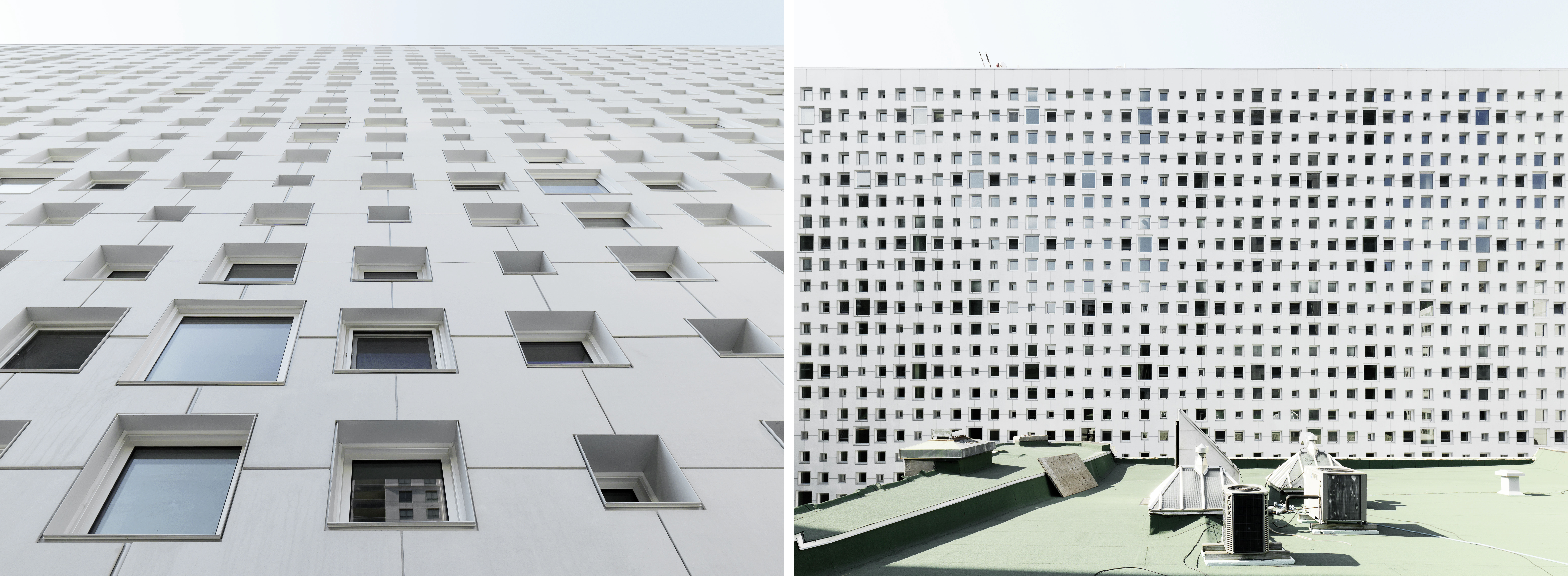Building the Ideal Rainscreen: Advantages of Extruded Concrete Panels
Extruded concrete has become an increasingly popular material choice because it is thinner, offers more design options, and is noncombustible
![]() Continuing Education
Continuing Education
Use the following learning objectives to focus your study while reading this month’s Continuing Education article.
Learning Objectives - After reading this article, you will be able to:
- Discuss the overall durability and performance benefits of including rainscreens in commercial buildings.
- List the common materials used to produce rainscreen.
- Compare and contrast common rainscreen materials.
- Describe the manufacturing process and performance benefits of extruded concrete.
The concept of a rainscreen appears to have originated in Norway centuries ago, where builders used the technique to protect church and barn walls with a layered structure, usually back-ventilated wood cladding that was placed over the top of a stone or wood wall, with an air gap in between. The layers—and the air gap—included open joints and promoted drainage of any moisture that entered the cladding layer.
Photo: Ema Peter Photography
Project: Syncline House
Architect: Omar Gandhi
Over time, the rainscreen design was modified for more modern use and was formalized as an architectural principle in 1962 by Scandinavian designer Birkeland, who took inspiration from old Norwegian barns. Later, the concept was amended in 1963 by Canadian architect G.K. Garden, who introduced the pressure-equalization concept to the design in Canada and coined the term “rainscreen.” Over the past several decades, the design principles have been tested and refined, and builders have increasingly been including rainscreen systems, commonly known just as rainscreens, as part of their building envelope. In the modern design, ventilation was built in through both top and bottom ventilation and drainage openings. These systems have been used extensively in both Canada and Europe since the 1980s. However, they have only started to become common in the United States over the past decade or so.
Rainscreen systems consist of three essential layers: the exterior cladding (the “screen”), a sealed air gap (or pressure-equalization chamber/PEC), and a water-resistive barrier (WRB) that is attached to the building’s frame. The rainscreen assembly must also include openings or vents that connect the air gap to the outside. This combination helps protect the structure by controlling external moisture (rain, snow, etc.) so that it does not reach the building’s internal substructure. The two standard rainscreen designs either drain water through the back-ventilation, as noted above, or use pressure equalization to moderate the air and moisture. Designers need to evaluate their project requirements and the environmental factors of the build site before deciding which rainscreen works best for their building.
The rainscreen itself usually refers to the actual siding, which can be made from a variety of different materials. Designers often choose the materials based on the potential impacts on the local environment (e.g., climate, pollution), the desired aesthetics, installation requirements, lifetime maintenance, and the project budget as a whole. Designers may also consider whether the panels are fire rated and if they add to the building’s green ratings. Rainscreen materials will be discussed in more detail later in this course.
When compared to other common systems, such as external thermal insulation systems (ETICS), the rainscreen has several advantages, such as moisture management and lower life-cycle costs. ETICS are wall insulation systems that are designed to provide the building with an added layer of insulation to protect against energy loss. The systems can be designed to change the face and character of the building, and consist of a base coat, a thermal insulation, adhesives, and a finishing coat. The main difference between ETICS and rainscreens is the former lacks an air gap in between the exterior and the interior, and that gap provides an added level of moisture management.
Building professionals may view the higher capital cost of rainscreens as a reason not to install them. However, the lifetime performance when compared to other alternatives show that the investment is usually worth it. Rear-ventilated rainscreens are highly efficient because of their high durability and low-maintenance design. This design, which includes an air gap between the cladding and the building substructure, means that the interior is protected, and thus has a longer life. In addition, it’s easy to add fire and lightning protection as well as noise buffers to rainscreens, thus adding to the overall benefits. ETICS systems, which lack that gap, insulate well and are useful in many situations. However, they are more prone to damage over time.
When we add in the differences between the initial manufacturing costs and ongoing maintenance costs throughout the product lifetime, the overall cost of different facades can vary. However in a head-to-head comparison, the rainscreen has features that boost its long-term performance and balance out the capital costs of the system when compared to less-durable designs.
Regardless of what kind of system designers choose, the rainscreen needs to be correctly installed. A properly installed rainscreen will help deflect water through eaves and cladding, will protect the walls by diffusing air via ventilation in the panel, and will drain any water that develops behind the cladding (for example, from condensation or seepage). The system also must dry any moisture and be durable enough to withstand environmental conditions and time.
Components and Installation of Rainscreens
As noted earlier, the three main elements of a rainscreen system are the exterior cladding layer (the “screen”), the pressure-equalization chamber (PEC), which has a water-resistant barrier along its sides, and the air gap, which is vented to the outside. Each of these three components has additional features to help keep the water out and to ensure that the system functions properly. It helps to look at the requirements for each element one at a time.
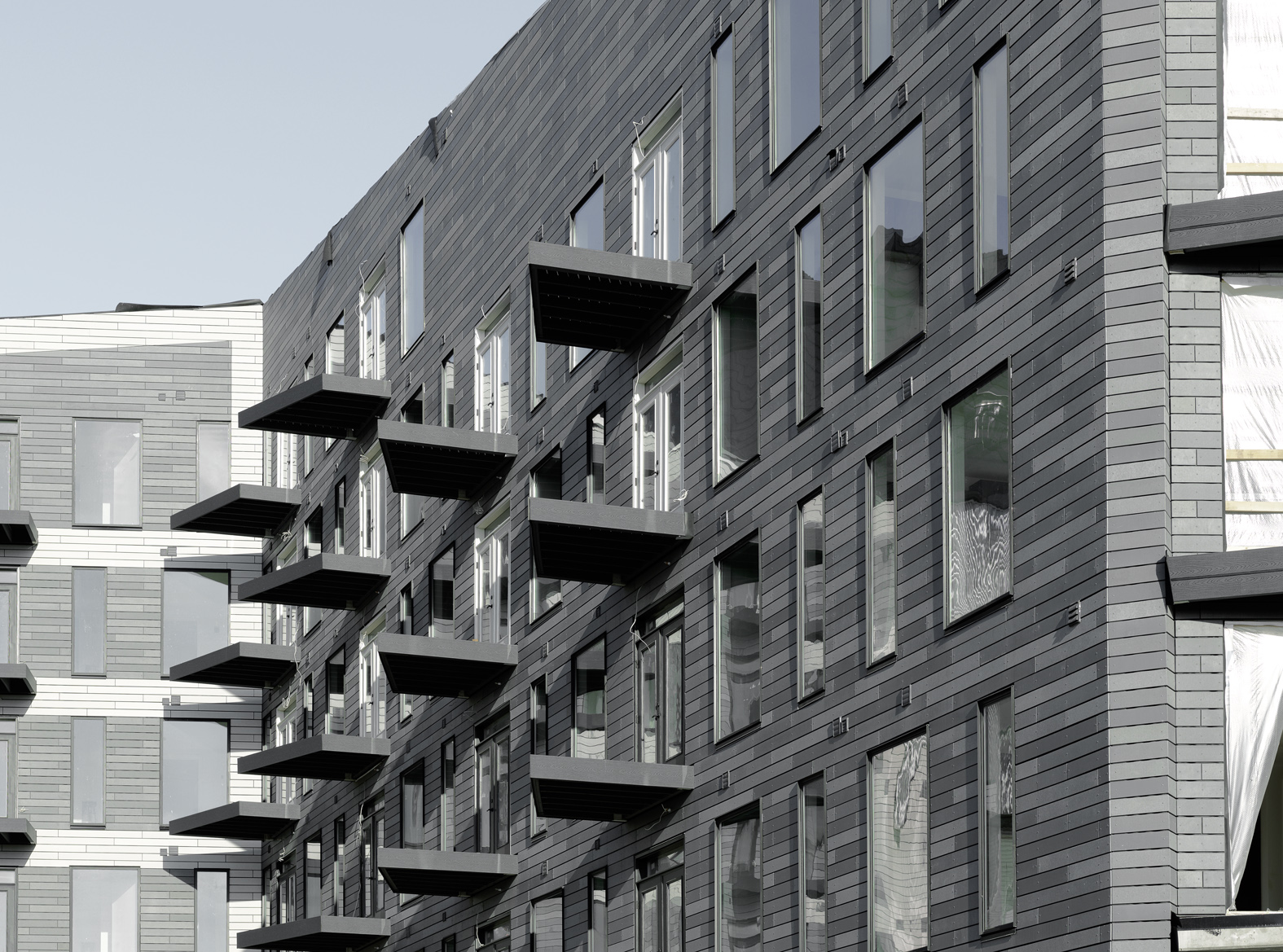
Photo: Rieder Group/Ditz Fejer
Project: Gravity Block
Architect: Architectural Alliance
Cladding: Ideally, the cladding is made of a nonporous, durable material, usually formed into panels. The goal of the cladding is to allow water to run off of it—and this means down both sides.
Air gap and vents (also “open joints”): The required air gap provides ventilation between the other two layers. Comments on the recommended gap size are discussed below. On the inside of the gap usually are interlocking dry joints that control the water and air flow through gravity, momentum, surface tension, and capillary action forces. The water-resistant barrier is also usually sealed with caulking, which is protected behind the cladding.
Finally, the pressure equalization chamber (PEC) requires careful design to work with the particular system. The PEC is a series of smaller, airtight chambers, and the size and depth of the chambers dictate how much air can be taken in and how big the given vents need to be. Most PECs also include chamber baffles that resist the wind and pressure loads inside the air gap and are often simply the fasteners that support the external cladding.
In addition to these main components—and their subcomponents—a well-designed rainscreen system also typically includes flashing and drip edges as a means of directing the water out of the air chamber and to the outside. Rainscreen panels may have drainage channels built into them for the purpose of draining the water.
Installation
A rainscreen system is usually installed to vertical furring, which is attached to the wall. The cladding is attached either to the framing or a substrate that can tolerate screws. Furring materials may include steel, wood, or plastic drainage mats, depending on the panel manufacturer’s requirements and builder’s preferences. All of this is done through the furring. Different manufacturers and designers will require that the air gap has a minimum spacing to ensure that the system works properly. However, even a 16⁄1-inch gap is considered adequate. That said, the reality is that most job-sites will require a gap of at least 1⁄4-inch to accommodate variations in material thicknesses. Some builders may wish to err on the side of caution and include even deeper air gaps, up to 3⁄4-inch; this depth is useful in wet climates since it provides more ventilation and thus can reduce drying times.
Builders should note that some rainscreen gaps are easier to work with than others. For example, a 1⁄4-inch or 3⁄8-inch gap can make it much simpler to trim out and flash a wall with 1⁄4-inch furring strips than to do the same job on a wall that has 3⁄4-inch strips. Another issue is that the air gap distance can dictate (and limit) the furring thickness, especially 44 if it’s being installed over thick rigid foam. Given that rainscreens require adequate furring to be properly attached, the air gap dimension does need to be carefully considered as part of the design process.
Keeping Water Out
Roofing and exterior walls receive bulk water impacts when it rains or snows, or even when conditions prompt exterior condensation, such as morning dew. While roofing systems are designed to shed water downward to the eaves, exterior walls are more exposed to variations in water flow. Moreover, water will react differently depending on its material. For example, a masonry wall will absorb water unless it has been protected with a water-resistant seal, and even then moisture may get in. Because masonry is porous, the moisture will seep through the entire surface, distribute the water, and will eventually dry—unless it encounters a weak spot in the joints, in which case it may leak.
Water that meets nonporous materials, such as metal and glass, hits the surface and can go any direction, depending on the weather conditions. For example, without wind, it may trickle downward, but in rainy, windy weather conditions, it can also push downward, laterally, or even upward under the roof. In windy situations, the water can also work its way into building corners. Again, if there is a weak point in the exterior cladding, the water has a chance to get through.
The rainscreen helps keep water out of the building interior by providing a barrier against the water outside and controlling any water that makes it past the cladding. The internal air gap and water-vapor barrier ensure that any water that does get in is drained through the gap and back outside. Some systems work to force air through the wall cavity/air gap to equalize the pressure between the exterior and interior wall, thus preventing any moisture from entering.
The primary goal of a rainscreen is to manage moisture, whether from a rain-soaked siding or a sheathing that has suffered from accumulated moisture during cold weather. A back-ventilated rainscreen system works to protect the building in several ways. First, the air gap in the system limits wicking between the back of the siding and the water-resistant barrier by providing a capillary break. In addition to preventing wicking action, the space also helps facilitate moisture drainage and airflow, thus protecting the building.
Any water that does accumulate is directed through the gaps provided by the assembly, where it can drain out. Finally, rainscreen walls that have top ventilation employ the stack effect principle, which, in this case, means that when the sun heats a surface (such as a wall), the air within the gap rises. The movement of rising and air escaping from the air gap can quickly dry any accumulated moisture within the wall system.
Risks of Water Entry
A well-built structure should have a thermal envelope that prevents any and all sources of moisture from entering it. Exterior moisture such as snow, rain, or even fog can cause tremendous structural problems, and groundwater entry from flooding can cause lasting damage to the building’s foundation. First and foremost, builders should ensure that the building envelope is designed to prevent any outdoor moisture from entering the building. In environments with extreme humidity and with frequent rain, a dehumidifier can help. However, the first goal is to keep the moisture out.
Unfortunately, in some situations, moisture does enter a structure. Water can enter the building envelope during or after construction, through wet wood or building materials, roof or window leaks, seepage into the basement, through the wall cladding, or any number of other sources. And when it does, bad things can happen. Most professionals in the building industry recognize that water or moisture damage is one of the most expensive problems that can occur to a building, especially if it happens after construction is complete, and even more so if the problem is continual.
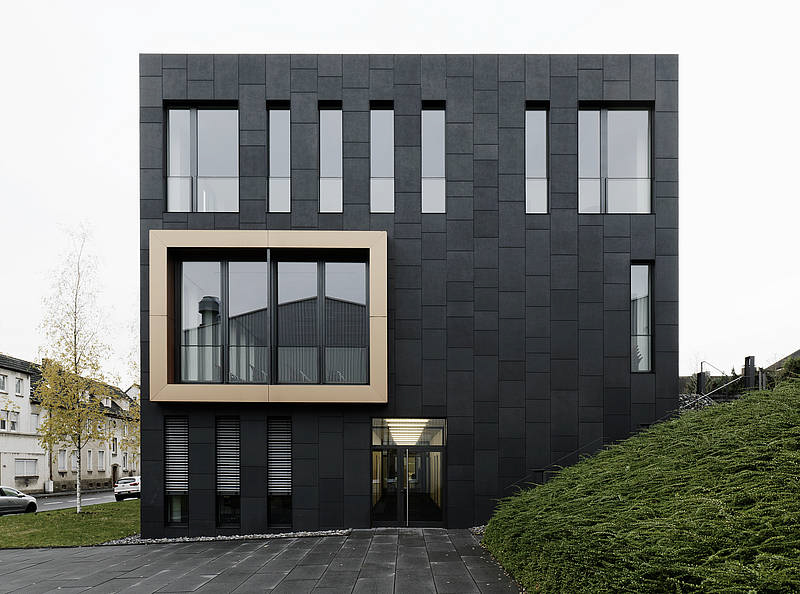
© Ditz Fejer
A multifunctional building for the Winner Spedition has been built in Iserlohn. In order to secure growth and quality for the future, the Winner Forum built a meeting point for internal staff training as well as office space for the IT department and central functions at the headquarters. The basic values for the three-story building, with a floor space of 1,200 square meters, are precision, sustainability, and energy efficiency.
Rainscreens Keeping Occupants Safe
Aside from rotting and warping wood, attracting insects, and damaging other building materials, water intrusion can create basement puddles, cause mold to develop on and within walls, and set off a chain reaction of many other problems. Mold issues, for example, quickly affect the air quality of the whole building and can affect the health, safety, and welfare of the occupants, usually in the form of respiratory illness.
Damp buildings and the associated moisture that can flow through the building’s airways can result in mold, fungus, and spore growth, which is then spread through the ventilation system and into the building’s air. Even more serious is if certain building materials begin to degrade from moisture exposure; many materials can release volatile organic compounds, which can cause significant adverse health effects with long-term exposure. Often the water intrusion and damage isn’t noticed until building occupants start to experience health problems. It goes without saying that the best practice is to ensure that the building envelope is sound and that moisture does not get into the building in the first place, and any moisture that does is dealt with immediately.
Given the seriousness of moisture in buildings, whether for potential structural damage, material degradation, or occupant health and safety, building professionals need to plan a water-mitigation strategy.
Cladding and facades that repel water and keep the building secure are necessary to ensure both durability and longevity of the building. In environments that have high humidity or exposure to moisture, such as coastal zones, a rainscreen system can be highly effective in keeping water out of the building. Designers should consider their water-mitigation strategy early on in the design process and recognize the value of a multilayered rainscreen system.
Building the Ideal Rainscreen
As part of a water-mitigation system, rainscreens first and foremost need to repel water. However, they also need to be durable enough to withstand other environmental forces, such as the wind, the sun, and extreme heat and cold, and to do so over time. Wood, for example, is porous and loses out on long-term durability. This leads us to stronger materials, such as metals, stone, glass, and concrete, all of which, when used as exterior cladding, can provide long-term protection without being negatively affected by the elements and moisture they are designed to withstand.
Architects and designers have a wide range of options of materials available that can satisfy this core requirement, while also contributing to an aesthetically beautiful building envelope. Some of the more commonly used materials for rainscreens are: aluminum composite materials (ACM), stone, fiber cement, high-pressure laminate (HPL), reconstituted stone, terracotta, timber, ceramic tile, glass reinforced plastic (GRP), fibrous concrete, or, more recently, extruded concrete. For the purpose of this course, we will focus on the commonly used fiberboard, cement board, cast-in-place concrete, and extruded concrete.
Fiberboard
Fiberboard is a composite material of plastic and wood fibers, often designed to mimic wood boards. As with wood, it can easily be painted, and is a cost-effective alternative for some applications. Fiberboard is usually used to make siding, and backerboard and is commonly used for siding and decks. While fiberboard is useful as a building material, it is not fire proof, which may be a concern. It is fire resistant, insect resistant, and is considered to be a neutral building material. Fiberboard is also non-toxic, sustainable, and durable, with a 50-year lifespan being standard for properly maintained surfaces.
Cement Board
Cement boards are large sheets constructed from a combination of cement-bonded particle board and reinforced cement fibers, but does not include aggregate. Standard dimensions are 4-foot-by-8-foot or 3-foot-by-5-foot. This versatile material can be nailed or screwed to building structures to create a substrate for fixtures such as tile floors, kitchen counters, or backsplashes. For building exteriors, cement boards can be used as a base for stucco, siding, or even on its own as the finish. As a rainscreen material, cement board offers durability, strength, and moisture resistance but is relatively heavy.
Cast-in-Place Concrete
Cast-in-place concrete is a mixture of aggregate and sand and is delivered ready-mixed in an unhardened state to the project site. The concrete is poured into molds, which often have rebar or other materials inside to reinforce the finished product. In addition to being used for building foundations, it can be used to construct beams, columns, floors, roofs, and walls. This type of concrete is very strong and durable, and it is touted as a sustainable solution because materials are usually locally sourced and any unused cement can be easily used for other projects. Cast-in-place concrete also has high thermal mass, and this can improve a building’s energy performance by creating an air barrier. The material’s light color also helps reduce the heat island effect by reflecting, rather than absorbing, heat. This feature can be beneficial when using cast-in-place concrete for an exterior rainscreen.
The final rainscreen material is extruded concrete.
Extruded Concrete
Extruded concrete is concrete set in thin layers that are reinforced with glass fiber. The material itself may be made with a ratio of 90 percent sand, 10 percent glass fibers, concrete additives and pigments for color. The panels are through-colored with available dimensions up to 177-inch length by 48-inch width.
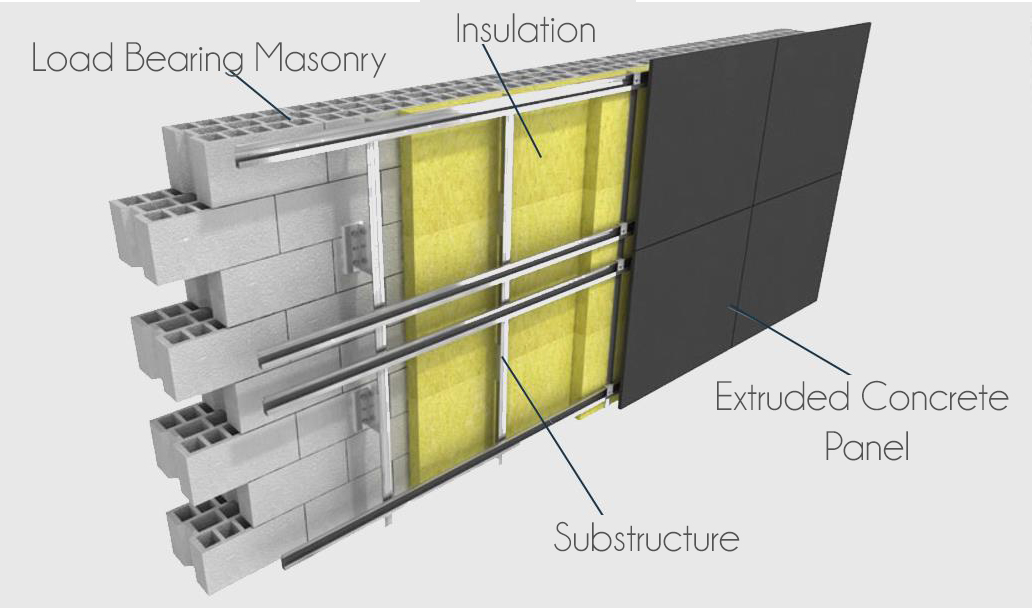
Image: Rieder Group
Extruded concrete panels are ultra thin and lightweight but exceptionally strong, durable, and non-combustible.
Panels made from this type of concrete are ultra thin and lightweight, with a thickness of 1⁄2-inch; making them at least half the thickness of cast concrete. More importantly, the material is exceptionally strong and durable, noncombustible, and is considered a high-performance concrete that works incredibly well in rainscreen assemblies. The material can be fixed with exposed rivets or screws (colors matching the panel color) or concealed using adhesive or undercut anchors.
Due to their light weight, high strength, and range of options for natural finishes, extruded concrete panels can be particularly useful in many systems where stone and precast concrete would be too heavy. Extruded concrete panels can be used effectively in both common types of cladding installations: unitized and panelized. Unitized glass curtain walls are large preassembled glazing units that are often used in large glass towers, installed on the outside of the concrete floor slabs. The glass and the extruded concrete architectural panels can be preassembled, loaded onto the floor with a crane or outside elevator, and installed from the inside of the building. Panelized installations include cladding sections that are premanufactured in entire wall sections complete with steel studs, architectural panels, and glass units. These very large panels are delivered to the site, and a crane is used to install them directly to the outside of the concrete floor slabs.
The extrusion process can quickly create very thin and very strong concrete panels, with some facilities manufacturing up to 30,000 square feet per day. The manufacturing process allows for creative design possibilities and a wide range of colors and surface treatments, thus making extruded concrete an optimal material for designers who wish to make an impact with their individual style.
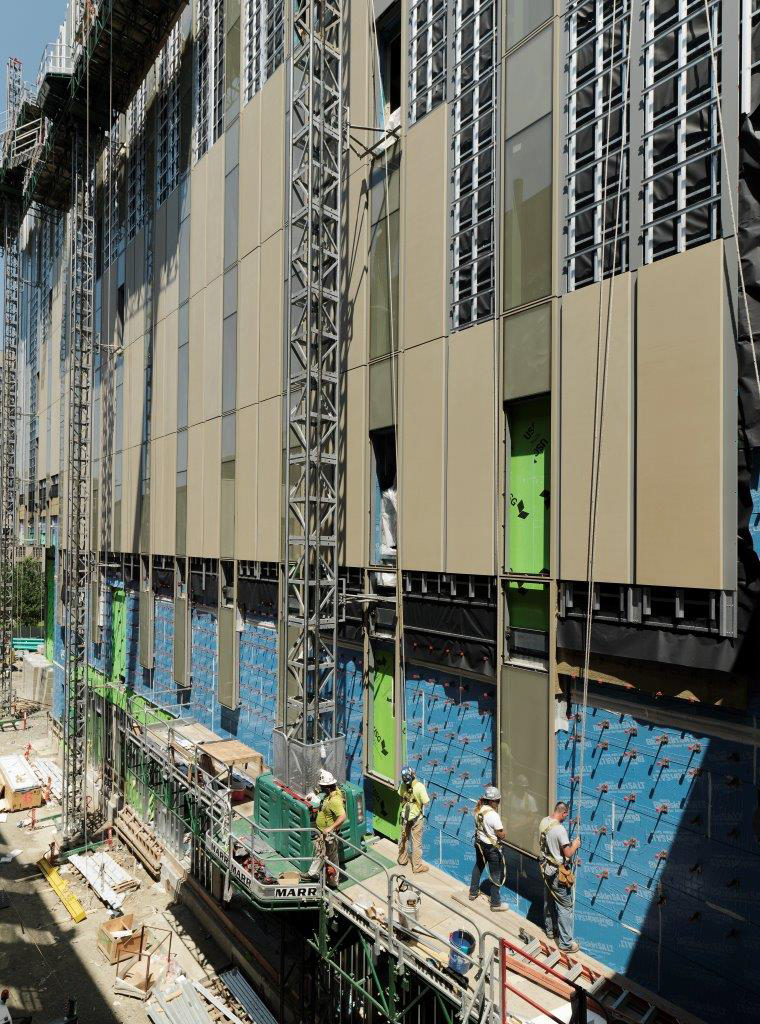
© Ditz Fejer
Boston University Center for Integrated Life Sciences & Engineering
Physical Attributes, Benefits, and Challenges of Typical Rainscreen Material
The goal of a rainscreen is to prevent moisture from entering the building shell, but also to provide an internal means of water drainage and evaporation if water does get through. Some systems work to force air through the wall cavity/air gap to equalize the pressure between the exterior and interior wall, thus preventing any moisture from entering. Regardless of the rainscreen design, a good rainscreen needs to meet the “ four Ds”: deflect water, drain moisture, dry any water that has penetrated the cladding, and be durable enough to withstand the elements over time without deteriorating.
The physical characteristics of exterior rainscreen cladding tend to follow the four Ds carefully, but with a strong emphasis on the durability. Ideally, the material will deflect water from the building surface or, if somewhat porous, will distribute and dry the moisture before it enters the air cavity. Some materials, such as ceramic tile or different metals, may have a high gloss that can help water shear away from the surface. The trade-off with various materials, however, is that they need to balance water mitigation with weight, strength, and overall durability. From an architectural standpoint, they also need some level of design flexibility.
Commonly used materials include fiberboard, cement board, cast-in-place concrete, and extruded concrete. Here’s how the various materials compare.
Water mitigation: Fiberboard, cement board, cast-in-place concrete, and extruded concrete are all highly moisture resistant. However, fiberboard is not commonly used for siding because of its low fire-resistant properties.
Weight: Material weight is a huge issue for both the shipping of materials to the project site and the installation. One of the main considerations is panel size and thickness, and how those dimensions work to meet a building’s needs. For example, extruded concrete panels are relatively lightweight and can easily be mounted. Larger, thicker panels may be required to handle dramatic temperature changes in extreme climates and strong wind loads. In most cases, extruded concrete panels meet the project needs in ways that fiberboard cannot.
Cast-in-place concrete is a different story in terms of delivery to the project site since it is “delivered” in a ready-mix form and poured on-site. However, by its nature, whatever is produced is very heavy since the thinnest mold tends to be 1-inch thick. Alternatively, extruded concrete is a relatively lightweight material. Panels that are 1⁄2inch thick do not incur the same high shipping rates as other materials, and the relatively light weight means that the panels are easier for the building team to install.
Strength: Rainscreens, and any other exterior cladding, needs to be strong enough to withstand high winds, debris, or natural elements, such as hailstones. They also must be able to handle freeze-thaw situations without cracking. When we compare the various cladding options, all of the materials stand up fairly well except for the fiberboard, which is not fire resistant. The three concrete materials are all very strong by nature, but over time, cast-in-place concrete tends to degrade if the internal rebar comes in contact with water and begins to rust. And concrete can develop pressure cracks when placed under heavy loads. However, the glass fiber layers embedded in extruded concrete create an incredibly strong material that can withstand almost anything that Mother Nature can throw at it.
Durability: When you’re dealing with exterior cladding that is exposed continually to the elements, durability is critical. Not only must the cladding be able to do its job as a rainscreen, but it must also be able to do so for a long time—if not the lifetime of the building. All concrete products do well in this category, particularly in comparison to wood. Even in climates that experience wintertime freeze-thaw cycles, the panels prove long-term resistance.
Design Flexibility: Given that a building’s exterior cladding is an important part of its architectural design, it is important that the material used for the exterior has some level of flexibility regarding its design, including color, shape, and texture. Fiberboard can be painted and look like wood, thus providing a long-lasting and safe design alternative to real wood. Cement board and cast-in-place concrete can both be polished to have a beautiful shine, sandblasted, or honed smooth for different surface textures, and cast-in-place can be done in a variety of shapes. Again, extruded concrete provides an attractive option; it is made of mineral-based raw materials, giving the panels their unique characteristics: lively surfaces with an interplay of color shades and light cloud effects, rather than dead and clinical surfaces, are characteristic of extruded concrete. Furthermore, it can be formed in flat panels or curves (“U” shapes), and it is through-colored instead of only painted. As a result, architects have a broad range of options for their design when they choose this material.

Photo: Rieder Group/Ditz Fejer
Project: 710 Grand
Architect: Brininstool + Lynch
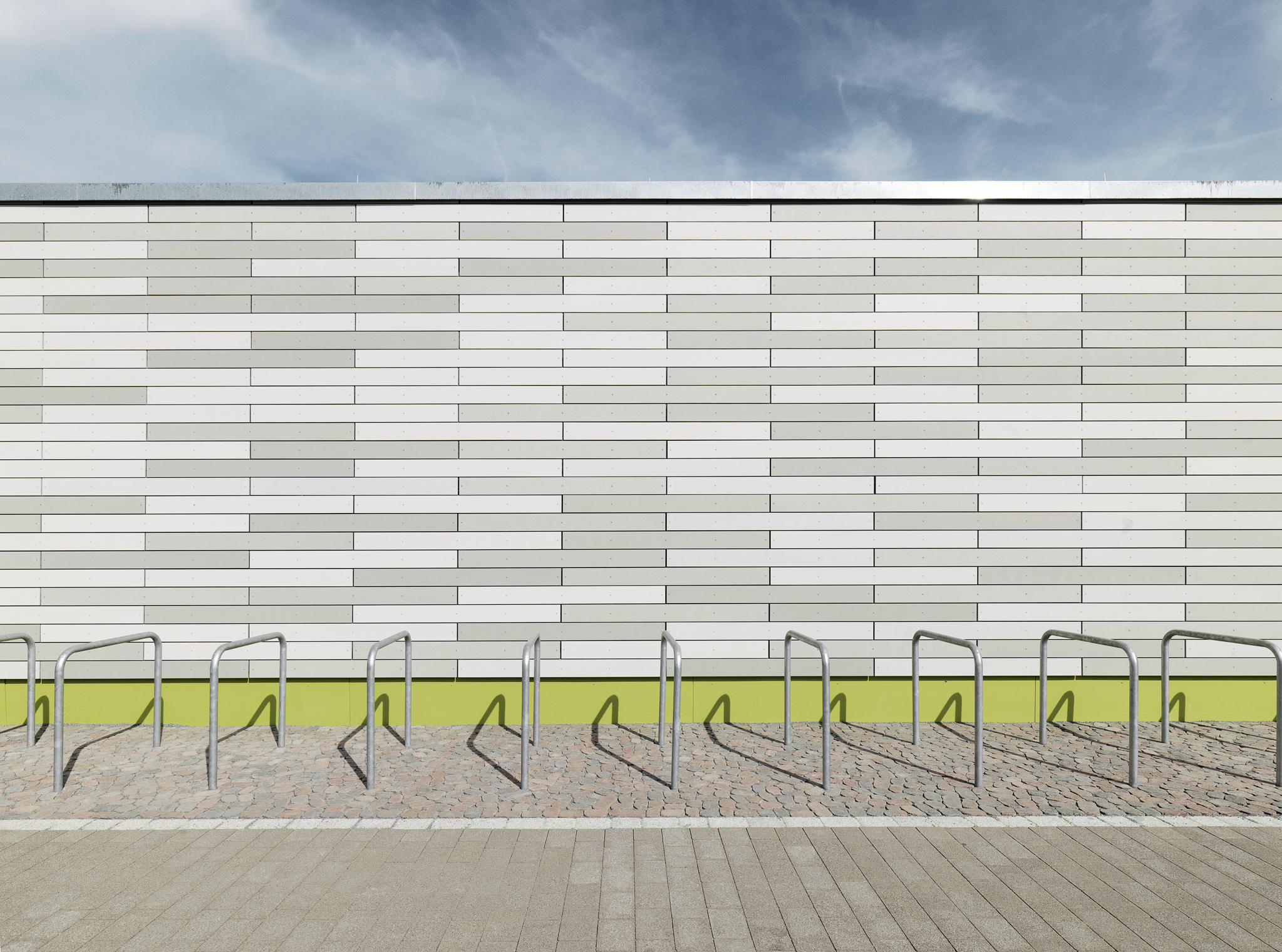
Photo: Rieder Group/Ditz Fejer
Project: School Alburg
Architect: Pielmeier
Understanding the Benefits of Extruded Concrete Panels for Rainscreens
Extruded concrete is an ideal material for rainscreens for many reasons. The manufacturing process creates a material that is thinner, stronger, and more manageable for designing and installing rainscreens. Also, extruded concrete is noncombustible and is available in a wide range of colors and finishes.
Andrew Rogers, president of Rieder North America, an extruded concrete manufacturing firm, has seen its products used in many applications.
“The 1⁄2-inch thick extruded concrete for flat rainscreen walls panels has been proven with over 10 years use in all parts of USA and Canada. The potential uses for this product are vast, including three-dimensional and curved parts for exterior and interior elements, flooring, and furniture,” he explains. “The future development of the product is also extensive, including thermally active facades, larger format panel sizes, and new and exciting textures, colors, and surfaces.”
Out of the concrete-based rainscreen materials, extruded concrete is quickly becoming a popular choice, and for good reason. Rainscreen panels made from extruded concrete layered with glass fiber can be rapidly produced, and the finished product combines many of the desired attributes necessary for quality rainscreens. The most notable qualities are that the finished product is a thin (1⁄2-inch), relatively lightweight, strong, and durable panel that is noncombustible and available in a range of colors and surfaces. By choosing to use rainscreens made from extruded concrete, designers can meet their aesthetic needs, all while using a superior product that is easy to install and will protect the building for a long time.
There are many advantages to extruded concrete rainscreens, most beneficial of which is the thickness tolerance. Cast-in-place concrete loses thickness tolerance, especially with a large sheet. Also, the extrusion is very fast, and it has the possibility of high output or production capacity. Some manufacturers can produce up to 30,000 square feet per day.
A 1⁄2-inch panel made of alternating layers of 3 millimeters of concrete and another layer of mesh made of glass fiber, followed by another 3-millimeter layer of concrete with chopped glass—repeated until 1⁄2-inch—makes for a high tensile strength and a durable panel.
The disadvantages don’t necessarily outweigh the advantages, but they need to be taken into account. For example, one of the limitations of extruded concrete is that it is limited to the width of the machine. So, if the machine width is 48 inches, that is the maximum-width panel that is available.
A beneficial feature of extruded concrete panels is that the products are naturally cured, typically for 28 days at room temperature. This curing process means that this aspect of their production requires very low energy use. If we compare this process to alternatives, such as aluminum, high-pressure laminates (HPL) coated with resin and paper, or cement board, extruded concrete comes out on top for manufacturing energy efficiency. The products are also all natural and thus are not prone to off-gas vapors in the way that other products might.
Extruded concrete panels have a wide range of color and texture options, which in turn makes them versatile for project design. Iron oxide is usually used to attain the product colors. The natural pigments blend in well with the natural environment to help designers achieve a seamless look between the project and the local landscape. In addition to colors, the panel surfaces can be sandblasted and honed to create vivid textures.
Finally, use of the product is highly versatile, especially when it comes to including original designs on a building’s exterior. Designers have the option of different panel sizes and shapes; for example, slat wall panels that can be easily installed by contractors or do-it-yourselfers. These panels require very little, if any, maintenance. In comparison to wood slat cladding, which needs to be treated or painted to maintain its appearance and durability, extruded concrete panels will retain their look through the lifetime of the product.
Another innovative element of the extruded concrete process is that it can be folded when wet and thus made into different shapes. Most commonly, panels are molded into “U” or “L” shapes that can be used to animate a building’s exterior, but the material can also be put in molds to create curved components. Architects may use U-shaped extruded concrete panels as exterior fins attached to the curtain wall to improve the solar shade capabilities on tall buildings. This 3-D design option has put concrete panels in direct competition with the traditional aluminum fins.
Conclusion
Rainscreen systems are quickly becoming an accepted part of building design, and for good reason. A clearly thought-out water-mitigation plan is an essential part of a project, and that plan can easily include durable, strong, stylish panels that make a bold statement. Extruded concrete panels bring a lightweight, naturally colored, and environmentally friendly option to the rainscreen system. Moreover, this versatile process of extruded concrete is quickly becoming a new way for designers to create 3-D forms that go beyond the basic flat panel.
OTHER OPTIONS: FINS, INTERIOR, DECKING, ROOF APPLICATIONS, FURNITURE—THE SKY IS THE LIMIT
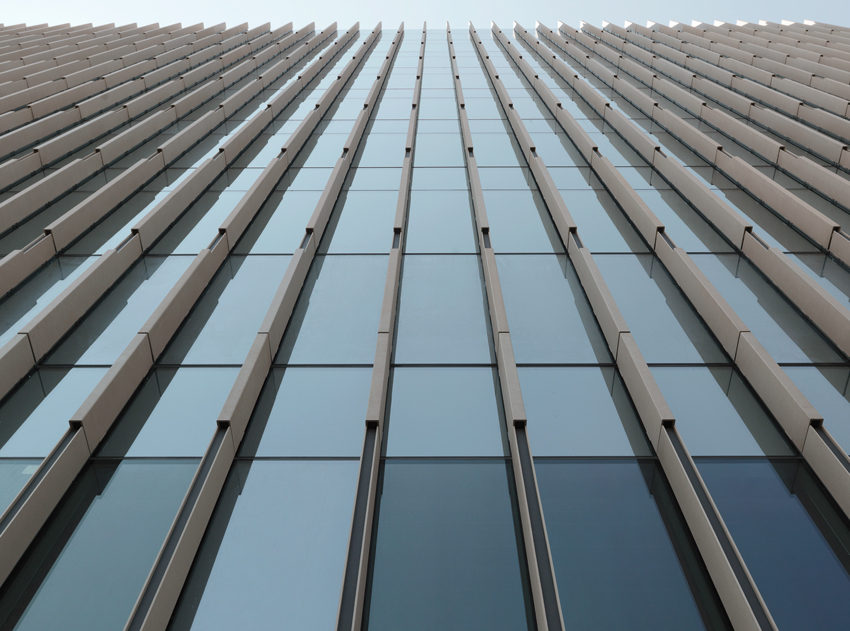
© Ditz Fejer
Extruded concrete is a versatile material. Here U-shaped ultra-thin folded fins made of extruded concrete were used for Boston University, Center for Integrated Life Sciences & Engineering.
Rainscreen and cladding systems aren’t the only use for extruded concrete forms. The material can be folded when wet and made into “U” shapes, “L” shapes, or put into a mold for curved parts. These unique shapes and designs can be incorporated into both interior and exterior features.
Folded concrete can replace traditional aluminum “fins” on building exteriors. Such fins provide solar shades on tall buildings and decorative adornments to the structure. With new 3-D concrete design as an option, fins can be designed and then installed directly onto the curtain wall.
Decks and rooftops can also benefit from the strength, durability, and light weight of extruded concrete panels. As a deck surface, for example, the material is able withstand foot traffic and deflect rain and snow, making it an affordable alternative to traditional wood decks. Moreover, the difference in maintenance requirements between a traditional wood deck and a concrete panel design is impressive: where wood requires stains, sealants, and occasional power washing to keep the wood in good shape, concrete will maintain its appearance without any risk of deterioration. This fact alone makes it a good choice over wood, which regardless of how well it is cared for will at some point begin to degrade, either from exposure to the elements or from bug infestation.
Moving away from exterior cladding, extruded concrete forms can also be created to enhance building interiors, whether through interior finishes or even custom-designed concrete furniture, such as tables, chairs, benches, or couches.
Andrew A. Hunt, vice president, Confluence Communications, has 16 years of experience in green building and has produced more than 100 educational and technical publications. www.confluencec.com

